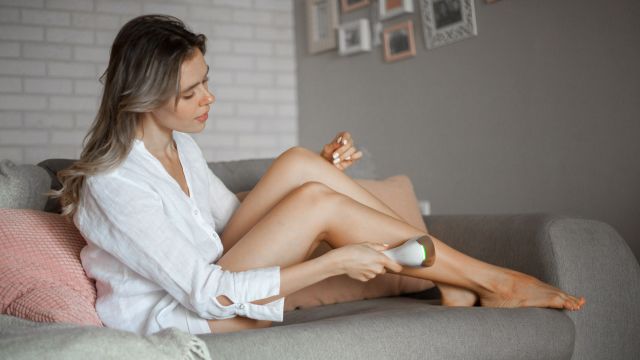According to stats from Clearpay, the biggest-selling beauty gadgets during the first few months of lockdown were electronic IPL (intense pulsed light) devices, as shoppers took the opportunity to zap away unwanted hair while they had more time at home and weren’t spending so much on salon visits.
While you may think that summer is the optimal time to begin hair removal, in fact, due to the nature of IPL treatment (which can’t be done when you’re tanned) and the time it takes, autumn or winter are actually the ideal seasons to prep your skin, ready for the warmer months.
There are a few factors to consider before you shell out upwards of £200 on an IPL device, however. Here, hair removal experts talk through everything you need to know…
What is IPL and how is it different to laser hair removal?
You may have seen both laser and IPL hair removal offered in salons. So, what’s the difference?
“Laser and IPL are both types of intense light,” says Alicia Trenchard, aesthetic practitioner and brand ambassador for Sensica. “The difference between them is that laser is a very focused, relatively narrow beam of just one specific colour or wavelength of the light spectrum, whereas IPL is a non-focused flash of light that consists of a range of colours and wavelengths.”
It’s important to note that IPL doesn’t actually remove hairs permanently. The flash of light causes the hair follicles to become dormant so they won’t grow, but they can ‘reactivate’ later, which is why top-up treatments are needed to keep skin hair-free in the long run.
What types of skin/hair colour is IPL suitable for?
Unfortunately, IPL technology does have some limitations, meaning it won’t work for everyone.
“IPL light is very easily absorbed by dark colour materials,” Trenchard says, which is why it’s most effective on darker hair. “This means if you have light brown or blond hair, the IPL is not very well absorbed, if at all, so less or no heat is created in the hair, and the treatment is likely to be less effective. Hair that is white, grey, red or very blond is not suitable for treatment with IPL or laser, as it will be completely ineffective.”
(Sensica/PA)
At the same time, because darker skin absorbs the light, IPL devices can’t differentiate between the hair and the skin.
“Due to the way the technology itself works, IPL isn’t suitable for the darkest skin tones, or Fitzpatrick skin tone six,” says Emily Buckwell, head of partnerships at beauty retailer CurrentBody.
That also means you shouldn’t do IPL when you’re tanned – whether real or fake – which is why it may be better to start treatment in autumn or winter.
“It is recommended to wait a minimum of four weeks after sun or sunbed exposure before applying IPL treatment,” Trenchard says. “You should also avoid applying fake tan or daily tan products for at least one week before.”
How should skin be prepared before IPL treatment?
“It’s very important to shave the hair before treatment. Any visible hair, stubble or debris on the surface of the skin will absorb the light energy, rather than the energy reaching the hair follicle,” says Buckwell.
Trenchard adds: “For best results, the hair must be in the follicle to be treated by the light, therefore do not wax, thread or tweeze the hair out.”
How long does it take?
“Each IPL pulse takes only a fraction of a second, so to cover an area of skin is very quick,” says Trenchard. “Treating an underarm will only take one or two minutes, whereas treating a larger area, such as legs, will take longer and depends on your height and leg diameter.”
Buckwell recommends 12 weekly treatments to begin with: “This allows you to target the hair follicle at different growth stages, meaning you’ll see long-term hair reduction. After that, we suggest a monthly maintenance treatment to keep up your results and target any small areas of regrowth.”
Are there any risks associated with at-home IPL?
“Home-use IPL devices are very safe, however, there is a very small risk of a few side effects, which if they do happen, are mostly temporary and resolved within a few hours or days,” Trenchard says. These can include skin redness, sensitivity or slight itching, or in rare cases swelling, burns or scarring. “These side effects can be avoided or minimised by carefully following the instructions for use.”
Buckwell agrees: “As long as it is used in accordance with the instruction manual, you shouldn’t experience any adverse side effects. IPL really works as long as you are consistent with your treatments.”5 of the best IPL devices to use at home
(Sensica/PA)
Sensica Sensilight Pro with RPL Technology For Permanent Hair Reduction, £375, Boots
(SmoothSkin/PA)
SmoothSkin Pure IPL Hair Removal Device, £251, CurrentBody
(Philips/PA)
Philips Lumea Prestige IPL Cordless Hair Removal Device, £390, Amazon
(Ulike/PA)
Ulike Diamond Air+, £215, CurrentBody
(Braun/PA)
Braun IPL Silk Expert Pro 5, £610, Amazon







